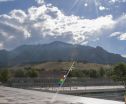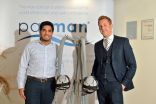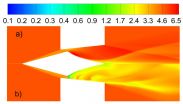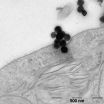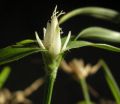(Press-News.org) By remotely "combing" the atmosphere with a custom laser-based instrument, researchers from the National Institute of Standards and Technology (NIST), in collaboration with researchers from the National Oceanic and Atmospheric Administration (NOAA), have developed a new technique that can accurately measure—over a sizeable distance—amounts of several of the major "greenhouse" gases implicated in climate change.
The technique potentially could be used in several ways to support research on atmospheric greenhouse gases. It can provide accurate data to support ongoing and future satellite monitoring of the composition of the atmosphere. With development, more portable systems based on the technology could provide very accurate, continuous regional monitoring of these gases over kilometer scales—a capability lacking with current monitoring techniques.
In the recent demonstration,* NIST's pair of laser frequency combs measured the simultaneous signatures of several greenhouse gases—including carbon dioxide, methane and water vapor—along a 2-kilometer path between a NIST laboratory roof in Boulder, Colo., and a nearby mesa.
Frequency combs are laser-generated tools made up of a large number of very precisely defined frequencies that are evenly spaced, like the teeth on a pocket comb. Each comb "tooth" represents an individual color, or frequency, enabling very accurate measurements of the characteristic absorption signatures of different gas molecules of interest.
Researchers identified gases in the atmosphere by measuring the amount of comb light absorbed at different frequencies during its trip from the NIST lab roof to a mirror on the mesa and back to a detector in a lab. Because the optical frequencies are too high to be measured directly, the researchers borrowed a trick from early radio. They created two combs with slightly different spacing between the teeth. Mixing light from these dual frequency combs together creates a "beat" frequency shifted down to the radio band, low enough to be measured. This was the first demonstration of the technique over long distances outdoors.
Remote sensing of atmospheric gases—from a satellite, for instance—can be performed with conventional instruments called spectrometers, but while satellite instruments have global coverage, they sample specific regions on Earth infrequently. Therefore, regional measurements are made with ground-based point sensors, which have a range that can be measured in meters and varies with wind conditions. There are no portable sensors that can measure multiple gases at long range with consistent results.
The NIST comb system was built to detect gases, including carbon dioxide, methane, and water over 2 kilometers. In principle, the dual-comb technique could detect an even wider range of gases over many kilometers. Accuracy in the measured atmospheric transmission is assured by the well-defined position of each frequency comb tooth. Because the technique makes repeated measurements rapidly over the same path, it is immune to signal distortions caused by atmospheric turbulence. And because the comb measurements can be averaged over the entire path length rather than relying on a few spot measurements, the comb method is better matched to the scale of atmospheric transport models.
In the demonstration, the research team collected data continuously for three days under varied weather conditions. The results were comparable to data collected by a nearby point sensor under well-mixed atmospheric conditions. The comb measurements were also very precise—with uncertainty of less than 1 part per million for carbon dioxide, for example, obtained in five minutes. That's precise enough to ensure detection of small increases in trace gases due to large, distributed sources such as cities. Future systems should be able to achieve even better sensitivities over shorter timescales.
Overall, the study results suggest that the dual comb technique is ideally suited to precise, reproducible sensing of trace gases in the atmosphere and can support the development of accurate models for use in global, satellite-based greenhouse gas monitoring. NIST researchers now plan to optimize the comb system by boosting power to improve sensitivity and expanding spectral coverage to identify additional gases. Portable frequency comb systems** could eventually support regional gas monitoring at costs comparable to point sensors, the researchers say, but over the kilometer scales relevant to many transport models and to monitoring of distributed sources such as large cities.
INFORMATION:
* G.B. Rieker, F.R. Giorgetta, W.C. Swann, J. Kofler, A.M. Zolot, L.C. Sinclair, E. Baumann, C. Cromer, G. Petron, C. Sweeney, P.P. Tans, I. Coddington and N.R. Newbury. Frequency comb-based remote sensing of greenhouse gases over kilometer air paths. Optica. Vol. 1, Issue 5. Posted online Oct. 29, 2014. DOI: 10.1364/OPTICA.1.000290.
** See "Portable Frequency Comb Rolls Out of the Lab" at http://www.nist.gov/pml/div686/sources_detectors/portable_frequency_comb.cfm.
The way a person's brain responds to a single disgusting image is enough to reliably predict whether he or she identifies politically as liberal or conservative. As we approach Election Day, the researchers say that the findings reported in the Cell Press journal Current Biology on October 30 come as a reminder of something we all know but probably don't always do: "Think, don't just react."
P. Read Montague of Virginia Tech says he was initially inspired by evidence showing that an individual's political affiliation is almost as heritable as height. Montague and his ...
Cancer suffers who lose their hair as a consequence of chemotherapy will benefit from a major research project that will improve the scalp cooling technology that prevents hair loss.
The research is being now underway and is being pioneered by global scalp cooling manufacturing company, Paxman Coolers, of Fenay Bridge, Huddersfield, in conjunction with the biology department of the University of Huddersfield.
The research will be led by key researcher Omar Hussain, who has a background in the pharmacology of cancer treatment, which he will use towards his PhD.
Omar ...
Researchers at University of California, San Diego School of Medicine have validated an EEG test to study and treat schizophrenia. The findings, published in two separate studies, offer a clinical test that could be used to help diagnose persons at risk for developing mental illness later in life, as well as an approach for measuring the efficacies of different treatment options.
One of the studies, reported online Oct. 23 in Schizophrenia Research, shows that schizophrenia patients don't register subtle changes in reoccurring sounds as well as others and that this deficit ...
Increasingly, cancer care respects the fact that a patient's body is only part of the system that requires treatment. Over a third of cancer patients experience psychosocial distress – the mental health consequences of their conditions. And, increasingly, care providers are exploring phone- and internet-based interventions to help cancer patients navigate mental health challenges. A University of Colorado Cancer Center study recently published in the journal Psycho-Oncology asks an important question: after decades of use and study, can we definitely show that remote ...
WASHINGTON, Oct. 29, 2014—Scientists and science fiction writers alike have dreamt of aircrafts that are propelled by beams of light rather than conventional fuels. Now, a new method for improving the thrust generated by such laser-propulsion systems may bring them one step closer to practical use.
The method, developed by physicists Yuri Rezunkov of the Institute of Optoelectronic Instrument Engineering, Russia and Alexander Schmidt of the Ioffe Physical Technical Institute in Saint Petersburg, Russia is described today in The Optical Society's (OSA) journal Applied ...
Your next pair of spandex pants could be made out of corn — or, more precisely, from dextrose derived from corn. This option is part of a new wave, albeit a small one, of consumer goods that are being produced from plants rather than petroleum-based materials. But a complete transition to a biobased economy won't be easy, according to an article in Chemical & Engineering News (C&EN), the weekly newsmagazine of the American Chemical Society.
Melody M. Bomgardner, a senior editor at C&EN, notes that a range of companies, from start-up firms to industrial giants, have ...
Researching the safety of nanoparticles is all the rage. Thousands of scientists worldwide are conducting research on the topic, examining the question of whether titanium dioxide nanoparticles from sun creams can get through the skin and into the body, whether carbon nanotubes from electronic products are as hazardous for the lungs as asbestos used to be or whether nanoparticles in food can get into the blood via the intestinal flora, for instance. Public interest is great, research funds are flowing – and the number of scientific projects is skyrocketing: between ...
New Rochelle, October 29, 2014 –Cities around the world are increasingly making urban data freely available to the public. But is the content or structure of these vast data sets easy to access and of value? A new study of more than 9,000 data sets from 20 cities presents encouraging results on the quality and volume of the available data and describes the challenges and benefits of analyzing and integrating these expanding data sets, as described in an article in Big Data, the highly innovative, peer-reviewed journal from Mary Ann Liebert, Inc., publishers. The Open ...
This news release is available in French. Everyone knows that exercise makes you feel more mentally alert at any age. But do you need to follow a specific training program to improve your cognitive function? Science has shown that the important thing is to just get moving. It's that simple. In fact, this was the finding of a study conducted at the Institut universitaire de gériatrie de Montréal (IUGM), an institution affiliated with Université de Montréal, by Dr. Nicolas Berryman, PhD, Exercise Physiologist, under the supervision of Dr. Louis Bherer, ...
This news release is available in German. Meiosis is not like another: Gabriela Cabral and Peter Schlögelhofer at the Max F. Perutz Laboratories (MFPL) of the University of Vienna and the Medical University of Vienna dived into the process of meiosis in specific plant species and revealed that these plants display an inversion of the standard meiotic phases. The researchers describe the detailed mechanisms in the scientific journal Nature Communications.
Meiosis is the two-step series of cell divisions that make sexual reproduction and genetic diversity possible.The ...
